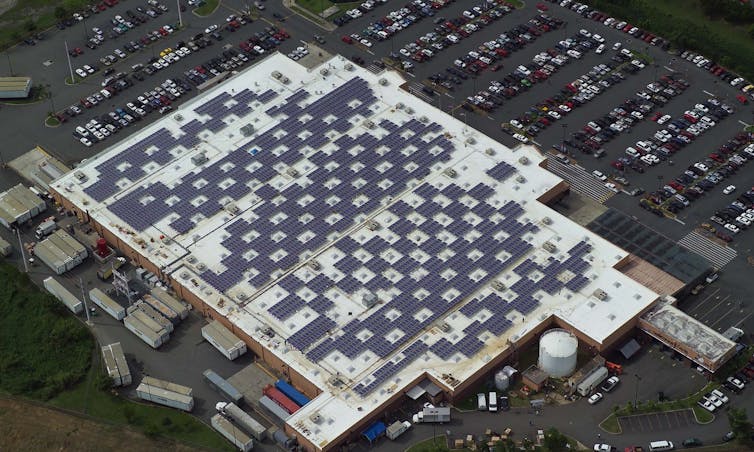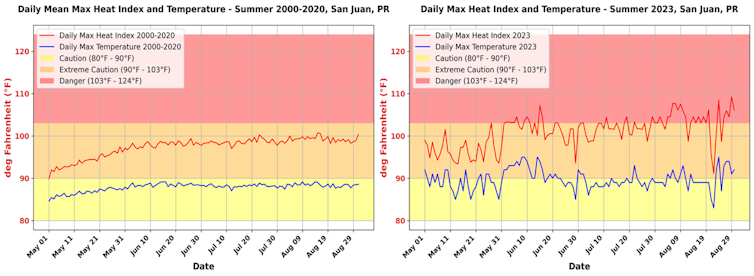Preparing for Atlantic hurricane season is always a priority in the Caribbean, especially when forecasts project high numbers of storms, as they do for 2024. The region’s most devastating storm in recent years, Hurricane Maria, struck in September 2017 and inflicted unprecedented destruction on Puerto Rico, Dominica, St. Croix and other islands.
Maria killed more than 3,000 people and caused about US$96 billion in damage. It devastated Puerto Rico’s electric power system, leaving 1.5 million customers in the dark for up to 328 days – the longest blackout in U.S. history. These outages had cascading impacts on other infrastructure, such as water and communications systems.
Today, the Caribbean region is experiencing new climate-related challenges. Prolonged extreme heat and humid days are increasing because of the accelerated warming of ocean waters.
In response to these increasingly frequent and extreme weather events, I teamed up with a dozen other researchers in 2023 to form the Caribbean Climate Adaptation Network. Our goal is to connect scientists with communities and government agencies in the U.S. Virgin Islands and Puerto Rico and to provide scientific information that can help them prepare for and respond to these emerging climate extremes.
I am a coastal-urban climatologist and a Puerto Rico native. Launching this network has been extremely important personally for me. I hope it will solidify our current partnerships for longer-term collaboration among leading academic researchers, vulnerable communities, government agencies and utility companies in the islands and serve as a platform to reach the entire Caribbean.
Our mission is to develop new ways of representing the coastal-urban environment as a unified system – one that places people at the center and integrates human-made systems, such as buildings and infrastructure, with natural systems, such as the atmosphere, ecosystems and oceans. All of these elements face the challenge of a changing climate. We want to support vulnerable communities by providing research that can make them more resilient against climate change and to bring them to the table so that we can create better solutions together.
Learning from Puerto Rico’s recovery
Puerto Rico has made its power grid more resilient in the years since Maria struck, but challenges remain. Over 1 million customers on the island have experienced intermittent outages since the Hurricane. In September 2022, Hurricane Fiona – a much weaker Category 1 storm – made landfall in Puerto Rico and caused an island-wide blackout.
Puerto Rico’s power system is fragile mainly because its infrastructure is aging and the island is naturally exposed to recurrent extreme events fueled by global warming. Nonetheless, local utilities have made significant progress in hardening a very complex power system at all points, from generation to distribution. Solar power generation – particularly small-scale rooftop installations that can power individual homes and businesses during grid outages – is playing a major role in making the system more resilient.

In 2023, I led a group of researchers in reconstructing the impacts of Hurricane Maria on Puerto Rico. We used a combination of geophysical models, engineering models of the power and water grids, reviews of damage reports and socioeconomic information to show how proposed hurricane preparedness strategies would affect low-income communities.
We learned that the most effective strategy to protect all community members was to harden the transmission system to handle impacts from Hurricane Maria-like events in the future. This will likely require new transmission towers capable of withstanding extremely high winds and soil saturation. It also could include limiting exposure through measures such as burying power lines. We did not research the costs of these solutions, but presumably they would be steep.
We’ve since joined again to reconstruct other major past weather events in Puerto Rico and gather new data, with a focus on resilient power infrastructure and adapting to a changing climate. For this work, we’re installing unique sensors on electricity transmission towers and wires, while observing the natural conditions around these transmission assets. These devices continuously measure mechanical stresses on the towers and the transmission lines’ capacity to manage power loads under varied weather and demand conditions, including extreme weather events.
By reconstructing past storms, collecting new data on the health of Puerto Rico’s infrastructure and using machine learning algorithms, we plan to develop new predictive modeling frameworks that can anticipate risks of disruption to the electric transmission system during extreme weather events.
Informing regional action
In recent years, our research group has used satellite observations to detect that Caribbean sea surface temperatures are increasing by nearly 0.9 degrees Fahrenheit (0.5 Celsius) per decade – some of the fastest ocean warming on Earth. This trend has direct implications for the risk of frequent and intense hurricanes.
It also affects ambient temperatures on land, including driving extreme heat conditions. In summer 2023, the city of San Juan experienced a prolonged heat wave, with heat indices above 100 F (38 C). This level is considered unhealthy for most people.
Heat advisories and record-breaking temperatures forced government officials to scramble to protect students. Public schools took the unprecedented step of canceling classes across the island. This event showed the importance of monitoring Caribbean ocean conditions and anticipating their effects on people, infrastructure and ecosystems.

My colleagues in the Caribbean Climate Adaptation Network and I believe that our findings will be transferable to other Caribbean communities. Our work also can inform coastal areas in the continental U.S. where critical infrastructure is heavily exposed and storms often hit the most vulnerable people hardest.
We hope that our work with communities will lead to broader education and new actionable science that can guide climate adaptation decisions and investments that reduce risks. Specifically, we aim to produce strategies for making island infrastructure far more resilient and adaptable, as well as safeguards to protect communities and maintain a sense of normality in a hotter climate.

